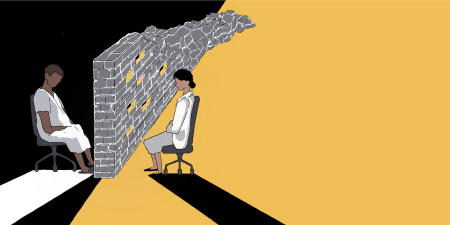Abstract
Shared decision making (SDM) is used in adult and pediatric practice for both its ethical and its practical benefits. However, its use is complicated with adolescents whose emerging and relational autonomy is distinct from that of adults, who make decisions independently, and children, whose parents make decisions for them. This hypothetical case scenario and commentary provide clinicians with a practical and stepwise approach to SDM with adolescents as well as guidance when SDM breaks down.
Case
Jordan was diagnosed with cystic fibrosis (CF) as a result of newborn screening and referred to a pulmonologist, Dr Fernandez. Jordan’s parents Peyton and Avery have worked with Dr Fernandez throughout Jordan’s life to make decisions that suit their family’s goal of Jordan enjoying as typical a childhood as possible and to empower Jordan with age-appropriate information about CF and treatment-related decisions (Step 0.a in Table).
At age 8, Jordan’s maintenance regimen consists of routine chest physical therapy (CPT) and medications, with technology dependence in the form of gastrostomy-tube (GT) nutrition overnight. At a regularly scheduled appointment, Peyton and Avery share with Dr Fernandez that Jordan has started to resist respiratory therapies. Dr Fernandez directs questions to Jordan, asking what makes completing the therapies difficult and if Jordan has any ideas about how to make these better. Jordan shares that he experiences nausea during CPT in the morning when his stomach is full from overnight GT feeds. Dr Fernandez states that the overnight feeds could be reduced if Jordan would be willing to take a can of nutritional supplement orally each day (Step 1.a-d in Table). Jordan agrees, and the dietician sends them home with several flavored nutritional supplements from which to choose (Step 0.c in Table).
At age 13, Jordan visits Dr Fernandez during a CF exacerbation. Pulmonary function tests show that increased home therapies have been insufficient, and Dr Fernandez concludes that a hospital admission is warranted. Jordan knows that admission is important, but he also wants to attend a long-anticipated concert that night. Peyton and Avery confirm that Jordan has been developing the ability to listen to his body and gauge when he is too sick to participate in activities. Together, the family and Dr Fernandez decide that the admission can be postponed until the following day, as long as Jordan’s symptoms do not worsen (Step 1.d in Table).
At age 16, Jordan’s CF has advanced, and Dr Fernandez refers him to the lung transplantation team for evaluation. Jordan undergoes extensive medical and psychosocial screening, and together with Peyton and Avery, receives education about what the transplantation process and life after transplantation might look like. Although transplantation is risky and will require significant hospitalization, Jordan and his parents decide that the potential for life prolongation outweighs the certainty of spending time at home on comfort-focused therapies (Step 1.a-e in Table).
However, there is disagreement about whether Jordan should be intubated or receive cardiopulmonary resuscitation (CPR) if his condition worsens during the wait for transplantation. The transplant team worries that if Jordan is sick enough to require intubation or chest compressions, it would be unlikely (but not impossible) for Jordan to get well enough to tolerate the transplantation procedure. Jordan has been intubated before and “hated it.” Avery and Dr Fernandez want to ensure that they do “everything possible” to give Jordan a chance at the longest life possible. Peyton is uncertain how to reconcile Jordan’s and Avery and Dr Fernandez’s perspectives. The palliative care team, which was consulted when Jordan was 14 years old, spends time separately and together with Jordan, Peyton, and Avery to allow them to process their feelings about these decisions and weigh the benefits and burdens (Steps 1.e and 2.d in Table). Eventually, Jordan decides that giving his mother the peace of mind of doing “everything possible” is worthwhile, despite his own reservations. Avery clarifies her desire is for intervention if Jordan has an unexpected event that might respond to treatment and states that she will honor Jordan’s wishes to refrain from invasive therapies if there is a slower decline that would be less likely to respond to treatment (Step 1.f in Table).
| Points in SDM | Strategy | |||||||||||||||||||||||||||||||||||||||||||||||||||||||||||||||||||||||||||||||||||||||||||||||||||||||||||||||||||||||||||||||||||||||||||||||||||||||||||||||||||||||||||||||||||||||||
|---|---|---|---|---|---|---|---|---|---|---|---|---|---|---|---|---|---|---|---|---|---|---|---|---|---|---|---|---|---|---|---|---|---|---|---|---|---|---|---|---|---|---|---|---|---|---|---|---|---|---|---|---|---|---|---|---|---|---|---|---|---|---|---|---|---|---|---|---|---|---|---|---|---|---|---|---|---|---|---|---|---|---|---|---|---|---|---|---|---|---|---|---|---|---|---|---|---|---|---|---|---|---|---|---|---|---|---|---|---|---|---|---|---|---|---|---|---|---|---|---|---|---|---|---|---|---|---|---|---|---|---|---|---|---|---|---|---|---|---|---|---|---|---|---|---|---|---|---|---|---|---|---|---|---|---|---|---|---|---|---|---|---|---|---|---|---|---|---|---|---|---|---|---|---|---|---|---|---|---|---|---|---|---|---|---|---|
|
Before a discrete treatment decision needs to be made |
Step 0
a. Get to know the patient. |
|||||||||||||||||||||||||||||||||||||||||||||||||||||||||||||||||||||||||||||||||||||||||||||||||||||||||||||||||||||||||||||||||||||||||||||||||||||||||||||||||||||||||||||||||||||||||
|
b. Set expectations for SDM. |
||||||||||||||||||||||||||||||||||||||||||||||||||||||||||||||||||||||||||||||||||||||||||||||||||||||||||||||||||||||||||||||||||||||||||||||||||||||||||||||||||||||||||||||||||||||||||
|
c. Engage the patient in smaller choices. |
||||||||||||||||||||||||||||||||||||||||||||||||||||||||||||||||||||||||||||||||||||||||||||||||||||||||||||||||||||||||||||||||||||||||||||||||||||||||||||||||||||||||||||||||||||||||||
|
d. Consider consulting palliative care. |
||||||||||||||||||||||||||||||||||||||||||||||||||||||||||||||||||||||||||||||||||||||||||||||||||||||||||||||||||||||||||||||||||||||||||||||||||||||||||||||||||||||||||||||||||||||||||
|
When it is time to make a decision |
Step 1 a. Define the medically reasonable options. |
|||||||||||||||||||||||||||||||||||||||||||||||||||||||||||||||||||||||||||||||||||||||||||||||||||||||||||||||||||||||||||||||||||||||||||||||||||||||||||||||||||||||||||||||||||||||||
|
b. Discuss the decision with the adolescent and his or her parent(s). |
||||||||||||||||||||||||||||||||||||||||||||||||||||||||||||||||||||||||||||||||||||||||||||||||||||||||||||||||||||||||||||||||||||||||||||||||||||||||||||||||||||||||||||||||||||||||||
|
c. Make a recommendation, if appropriate. |
||||||||||||||||||||||||||||||||||||||||||||||||||||||||||||||||||||||||||||||||||||||||||||||||||||||||||||||||||||||||||||||||||||||||||||||||||||||||||||||||||||||||||||||||||||||||||
|
d. Honor medically reasonable decisions. |
||||||||||||||||||||||||||||||||||||||||||||||||||||||||||||||||||||||||||||||||||||||||||||||||||||||||||||||||||||||||||||||||||||||||||||||||||||||||||||||||||||||||||||||||||||||||||
|
e. Acknowledge emotions; allow more time for decision making, if possible. |
||||||||||||||||||||||||||||||||||||||||||||||||||||||||||||||||||||||||||||||||||||||||||||||||||||||||||||||||||||||||||||||||||||||||||||||||||||||||||||||||||||||||||||||||||||||||||
|
f. Accept different levels of SDM with different families. |
||||||||||||||||||||||||||||||||||||||||||||||||||||||||||||||||||||||||||||||||||||||||||||||||||||||||||||||||||||||||||||||||||||||||||||||||||||||||||||||||||||||||||||||||||||||||||
|
When SDM becomes difficult |
Step 2 a. Consider obtaining an ethics consultation. |
|||||||||||||||||||||||||||||||||||||||||||||||||||||||||||||||||||||||||||||||||||||||||||||||||||||||||||||||||||||||||||||||||||||||||||||||||||||||||||||||||||||||||||||||||||||||||
|
b. If the patient and parent(s) decline all medically reasonable options, consider seeking state intervention to compel the adolescent to undergo the recommended therapy. |
||||||||||||||||||||||||||||||||||||||||||||||||||||||||||||||||||||||||||||||||||||||||||||||||||||||||||||||||||||||||||||||||||||||||||||||||||||||||||||||||||||||||||||||||||||||||||
|
c. If the patient and parent(s) request potentially nonbeneficial or harmful treatments, maintain a therapeutic relationship and be flexible, but consider contacting state authorities to protect the patient from harm if the family elects to pursue a harmful therapy. |
||||||||||||||||||||||||||||||||||||||||||||||||||||||||||||||||||||||||||||||||||||||||||||||||||||||||||||||||||||||||||||||||||||||||||||||||||||||||||||||||||||||||||||||||||||||||||
|
d. If the patient and parent(s) disagree about the best treatment plan and both preferred courses of action are medically reasonable, reengage in SDM but acknowledge that parents have the legal authority to make a final decision. |
||||||||||||||||||||||||||||||||||||||||||||||||||||||||||||||||||||||||||||||||||||||||||||||||||||||||||||||||||||||||||||||||||||||||||||||||||||||||||||||||||||||||||||||||||||||||||
|
Abbreviation: SDM, shared decision making.
|
||||||||||||||||||||||||||||||||||||||||||||||||||||||||||||||||||||||||||||||||||||||||||||||||||||||||||||||||||||||||||||||||||||||||||||||||||||||||||||||||||||||||||||||||||||||||||
Pediatric Shared Decision Making
Shared decision making (SDM) is an important aspect of patient-centered medical care because it integrates a patient’s (and family’s) values, goals, and preferences with a clinical team’s knowledge of treatment options and outcomes.1 Conceptually, SDM holds 2 important bioethical principles in tension—beneficence and respect for autonomy.2 Clinicians seek to help their patients by recommending therapies that are medically beneficial. Although adult patients agree to treatments that they believe will suit their values, goals, and preferences, they are also allowed, in most cases, to decline.3
Medical decisions have reciprocal implications for an adolescent patient’s identity and relationships to others.
Other principles come into play when parents participate in SDM with clinicians on behalf of children who are patients. Children should be involved in decisions regarding their health, providing assent to the degree they are able,4 but ultimately it is their parents who have decisional authority.5 In these decisions, while beneficence and autonomy continue to be important, protecting children from harm becomes the priority. Indeed, if a family’s decision about which treatment to receive or decline puts a child at risk of serious harm, there is both legal and ethical support to override parental autonomy.5
SDM with adolescents, who find themselves developmentally and chronologically between childhood and adulthood, is especially hard.6 How should clinicians uphold their fiduciary duty to protect patients from harm while respecting parents’ legal authority and adolescents’ autonomy? Adolescent autonomy contains several layers, each of which manifests differently in different individuals.7
Adolescent Autonomy
Emerging autonomy. The cognitive and emotional regulation skills required to make decisions evolve during adolescence. It has long been known from laboratory experiments that youth as young as 14 can understand medical information and come to reasoned decisions resembling those of young adults.8 However, teenagers are less likely than adults to engage their rational decision-making abilities in emotionally fraught situations with psychosocial implications, such as important or stressful medical decisions.9 Clinicians, who have a duty to protect adolescents from harm, must consider if adolescent patients are protecting their own interests when they are engaged in SDM.
Relational autonomy. While some may not consider a decision autonomous unless reached completely independently, it is unrealistic and developmentally inappropriate to expect adolescents (and, most likely, patients of all ages) to be completely independent or to ignore the important people in their lives when making medical decisions.10 Rather, adolescents commonly consider the perspectives of peers and family as well as how their decisions will impact others. The extent to which adolescents depend on guidance from their parent(s), peers, and other important people in making decisions varies. Life experience and social location contribute to adolescents’ desire for independence and belief that their own opinion should be the deciding factor.7,11 How hands-off a parent is willing to be depends on his or her parenting style, knowledge and comfort with medical decisions, and culture.4,12,13,14 Adolescents might also consider the perceptions and expectations of their peers and social networks when making life choices, including medical decisions.9 Finally, medical decisions have reciprocal implications for patients’ identity and relationships to others. Adolescents might consider what decision a “good” child, “brave” patient, or “independent” actor would make, thereby infusing their perception of others’ opinions into their medical decision. When engaging in SDM, clinicians should seek to understand the extent to which an adolescent is weighing others’ opinions in making a decision and if this level of consideration promotes the adolescent’s health and healthy relationships.
Strategy for SDM With Adolescent Patients and Their Parents
Ideally, there would be a standardized assessment to determine adolescents’ capacity for assent or consent and therefore how involved in decision making they should be. Authors have suggested various tests and considerations.12,13,15 However, given the many fluctuating variables involved in adolescent autonomy (eg, cognitive development, emotional state, others’ influence, and desire for independence), we consider it unlikely that further research will produce an evidence-based, clinically feasible evaluation to neatly solve this complex problem. Therefore, we share our own approach to SDM with adolescent patients and their parents that is outlined in the Table and illustrated in the above case.
- Step 0: Before a discrete treatment decision needs to be made
- Take the opportunity to get to know the patient; the patient’s values, goals, and preferences; and how the family makes decisions together.
- Explain that, when it comes time to make treatment decisions, you will seek to respect the opinions of both the adolescent and the parent(s) and ensure that the adolescent remains safe.
- Engage the child or adolescent in small choices related to the patient’s care to help the patient practice weighing benefits and burdens in light of his or her goals, values, and preferences.16
- If the patient has a chronic or potentially life-limiting diagnosis, consider consulting a palliative care team to help the patient and family elucidate their values, goals, and preferences and apply them to future decisions. (Palliative care is not limited to end-of-life care and is not a sign of “giving up.”)
- Step 1: When it is time to make a decision
- Use evidence-based medicine and your medical judgment to determine which treatment(s) will benefit the patient or at least enable the patient to avoid serious harm; these are the medically reasonable options.
- Engage the adolescent and the adolescent’s parent(s) in a discussion about the medically reasonable treatment options and how their values, goals, and preferences would fit with each option.
- If there is one option that appears medically superior or that you believe best fits the values, goals, and preferences of the adolescent and parent(s), make this recommendation and explain why.
- Allow the adolescent and parent(s) to choose any of the medically reasonable alternatives they believe fits best. Be flexible if there are preferences that can be accommodated without affecting the efficacy of the treatment(s).
- Enhance the adolescent’s decision-making capacity by acknowledging and exploring the emotions that the decision brings up. If it seems the adolescent is making decisions based on emotion rather than reason (as is common based on adolescent neurocognitive development in difficult situations9), help the adolescent (and family) reflect on their thoughts and explore the values guiding their choice. If possible, give the adolescent and family additional time to consider the options; decision making can pivot from emotional to rational when patients and families have time to process their emotions and deliberate on the impending decision.17
- Recognize that different families will share similar decisions in different ways based on their ideal of relational autonomy. This varied “sharedness” is acceptable as long as the adolescent and parent(s) are comfortable with the process and choose a medically reasonable treatment option.
- Step 2. When SDM becomes difficult
- Consider obtaining an ethics consultant to act as an objective third party in assisting you in weighing harms and benefits and ensuring that everyone’s perspective is heard.
- If, after multiple conversations, the patient and parent(s) decline all medically reasonable options, consider seeking state intervention to compel the adolescent to undergo the recommended therapy. Weigh the likelihood and significance of the potential benefit against the risks of breaking the family’s trust in the clinicians, the psychosocial harm of forcing an adolescent to act against values in which he or she is highly invested, and the feasibility of forcing someone to undergo therapy.7,9 Respectfully explain to the family your concerns and the process of involving authorities.
- If the patient and parent(s) request potentially nonbeneficial or harmful treatments, maintain a therapeutic relationship. Ask questions to gain understanding of the goal behind the family’s request and consider if there is a medically reasonable way to meet it. Explain your concerns. Ask what the patient and family think about these concerns. For potentially nonbeneficial treatments, consider multiple definitions of benefit. For example, if a treatment aids in prolonging life but cannot provide a cure and the family has expressed that goal, then it may provide benefit of a different sort. Offer a time-limited trial, based on when clinically significant benefit would be expected if the therapy were effective. For potentially harmful treatments, offer to connect the family with other reputable clinicians to get a second opinion. If these efforts fail and the family plans to pursue harmful therapy—either independently or under the direction of an unqualified clinician—weigh the risk and magnitude of the harm of the planned therapy against that of reporting the family to state authorities. If the harm from the therapy is very likely and serious, inform the family of your duty to contact state authorities to protect the patient from harm.
- If the patient and parent(s) disagree about the best treatment plan and both preferred courses of action are medically reasonable, reengage in conversations to elucidate the values, goals, and preferences that drive this difference. Help the family differentiate between essentials and “nice to have’s,” and think creatively about how to meet each person’s essentials. Acknowledge that parents have the legal authority to make a final decision. Ask them to consider the loss of trust and psychosocial harm of forcing an adolescent to act against values in which he or she is highly invested and the feasibility of forcing their child to undergo therapy. Make every attempt to convince the adolescent to agree with the treatment.18
Conclusion
Adolescence is characterized by emerging and relational autonomy, identity development, and social relationships. All of these factors impact adolescent, family, and clinician medical decision making. Thus, SDM with an adolescent requires a somewhat different strategy than SDM with an adult or a young child’s parent(s). We suggest that clinicians engage with an adolescent patient and his or her parent(s) before a decision is required to understand the family’s treatment values, goals, preferences, and decision-making style and to communicate how decisions will be made together. At the time of a health care decision, clinicians should identify all medically reasonable alternatives and help the adolescent patient and parent(s) to choose among these. Finally, when a shared decision cannot be reached, clinicians must honestly compare the harms and benefits of the proposed action plans and acknowledge parents’ legal authority to decide, as long as the chosen option is medically reasonable. If the family elects to pursue an option that is not medically reasonable, the clinician must weigh the risks and benefits of involving state officials to protect the adolescent from harm. When an adolescent’s emerging autonomy must be curtailed out of concern for the patient’s well-being, it is especially important to treat the adolescent with respect.
References
- Charles C, Gafni A, Whelan T. Shared decision-making in the medical encounter: what does it mean? (or it takes at least two to tango). Soc Sci Med. 1997;44(5):681-692.
-
Beauchamp TL, Childress JF. Principles of Biomedical Ethics. 5th ed. New York, NY: Oxford University Press; 2001.
- Kon AA. The shared decision-making continuum. JAMA . 2010;304(8):903-904.
- Scherer DG. Pediatric participation in medical decision making: the devil is in the details. Am J Bioeth. 2018;18(3):16-18.
- Diekema DS. Parental refusals of medical treatment: the harm principle as threshold for state intervention. Theor Med Bioeth. 2004;25(4):243-264.
-
Weiss EM, Clark JD, Heike CL, et al. Gaps in the implementation of shared decision-making: illustrative cases. Pediatrics. 2019;143(3):e20183055.
-
Levetown M; American Academy of Pediatrics Committee on Bioethics. Communicating with children and families: from everyday interactions to skill in conveying distressing information. Pediatrics. 2008;121(5):e1441-e1460.
- Weithorn LA, Campbell SB. The competency of children and adolescents to make informed treatment decisions. Child Dev. 1992;53(6):1589-1598.
-
Diekema DS. Adolescent refusal of lifesaving treatment: are we asking the right questions? Adolesc Med State Art Rev. 2011;22(2):213-228.
-
Sherwin S. A relational approach to autonomy in health care. In: Sherwin S, ed. The Politics of Women’s Health: Exploring Agency and Autonomy. Philadelphia, PA: Temple University Press; 1998:19-46.
- Davis G, Ray R. Pediatric participation in a diverse society: accounting for social inequalities in medical decision making. Am J Bioeth. 2018;18(3):24-26.
- Masty J, Fisher C. A goodness-of-fit approach to informed consent for pediatric intervention research. Ethics Behav. 2008;18(2-3):139-160.
- Miller VA, Drotar D, Kodish E. Children’s competence for assent and consent: a review of empirical findings. Ethics Behav. 2004;14(3):255-295.
- Lipstein EA, Brinkman WB, Britto MT. What is known about parents’ treatment decisions? A narrative review of pediatric decision making. Med Decis Making. 2012;32(2):246-258.
- Michaud PA, Blum RW, Benaroyo L, Zermatten J, Baltag V. Assessing an adolescent’s capacity for autonomous decision-making in clinical care. J Adolesc Health. 2015;57(4):361-366.
- Miller VA. Involving youth with a chronic illness in decision-making: highlighting the role of providers. Pediatrics. 2018;142(suppl 3):S142-S148.
- Prouty CD, Mazor KM, Greene SM, et al. Providers’ perceptions of communication breakdowns in cancer care. J Gen Intern Med. 2014;29(8):1122-1130.
- Ross LF. Against the tide: arguments against respecting a minor’s refusal of efficacious life-saving treatment. Camb Q Healthc Ethics. 2009;18(3):302-315.



